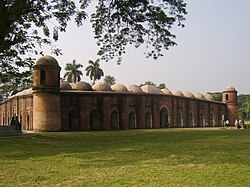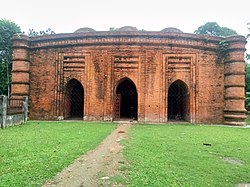Historical mosque town of Bagerhat
| Historical mosque town of Bagerhat | |
|---|---|
|
UNESCO world heritage |
|

|
|
| Bagerhat - "Sixty-Dome Mosque" |
|
| National territory: |
|
| Type: | Culture |
| Criteria : | (iv) |
| Reference No .: | 321 |
| UNESCO region : | Asia and Pacific |
| History of enrollment | |
| Enrollment: | 1985 (session 9.) |
The Historic Mosque City of Bagerhat , formerly Khalifatabad , belongs since 1985 because of its numerous Islamic monuments of the 15th and 16th centuries to the World Heritage of UNESCO .
location
Bagerhat is located in the district of the same name in the Khulna division in Bangladesh on the Bhairab River at a height of approx. 10 m .
history
The city was in the early 15th century by Turkish descent General Khan Jahan Ali under the last sultan in Delhi ruling Tughlaq Dynasty , Nasir-ud-din Mahmud Shah founded (r. 1442-1459).
Attractions
- About 7 km west of the city is the "sixty-domed mosque" (ষাট গম্বুজ মসজিদ, IAST : Ṣāṭa gambuja masajida, Shaith-Gumbad-Masjid ) built on a rectangular plan and made of fired bricks . It was built at the beginning of the 15th century on behalf of the military leader Khan Jahan Ali, who - until his death (1459) - regional and de facto independent ruler of Khalifatabad in the style of the mosque buildings of the Tughluq dynasty ( cf.Khirki Mosque (Delhi) ) built. The outer walls, with their sparse terracotta applications, and the pillars inside, support a Bengali-style roof dominated by 77 domes and slightly arched in the middle on all four sides . Four more domes close off the corner towers, of which the two front ones are designed as stair towers . Three sides of the mosque are opened by portals; only the west (= Mecca ) oriented qibla wall is closed as usual. A narrow entrance to the right of the mihrab was probably reserved exclusively for the ruler, in this case Khan Jahan Ali.
- The founder of the mosque is venerated today by many Muslims as a “saint” and his domed mausoleum with hanging roof corners, which is located near Bagerhat, is an important pilgrimage site. The funerary mosque is a fine example of a single-dome mosque (Ek Gombuz) .
- Another historically significant mosques in Bagerhat is significantly smaller and built on a square plan "Nine-domed mosque" (Noi Gombuz Masjid) , which according to tradition in the 16th century by a general of the army of the first Mogul -Herrschers Babur built has been. There is already a somewhat more pronounced curvature of the roof as well as geometric decorative motifs in the facade design (e.g. checkerboard pattern ). The three portals on the east side each close with a decorative triple lintel beam. The corners are each formed by round stair towers .
- A similar building scheme - but with only one large central dome - can also be found in the Chuna Khola Masjid , the Singara Masjid and the Ronvijoypur Masjid .
Web links
Commons : Archaeological Sites in Bagerhat District - Collection of images, videos and audio files
- Mosques of Bagerhat - Photos and information (English)
- Sixty-Dome Mosque - Photos, Floor Plan + Info (Banglapedia English)
- Article on Khan Jahan (Banglapedia English)
- Article on Khalifatabad (Banglapedia English)
Individual evidence
Coordinates: 22 ° 39 ′ 25 ″ N , 89 ° 47 ′ 45 ″ E


